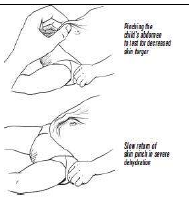- Is the child lethargic?
- Does the child have sunken eyes?
- Does a skin pinch take longer than 2 seconds to go back?
- Can the child suck or drink?


After completion of this chapter the participant should be able to:
In triage the letter D stands for Dehydration. In this chapter, we will look at the assessment of the degree of dehydration in the infant with diarrhoea, vomiting, or due to poor feeding.
The normally frequent yellowish or slightly greenish loose seedy stools (like a pea soup) a few times (this is subjective) per day of breastfed babies are not diarrhoea. These are normal breast feeding stools.
If the stools have changed from the usual pattern and are many and watery, it is diarrhoea.
When a young infant presents with diarrhoea or vomiting:
Ask:
Examine the infant and assess the severity of dehydration.


| Degree of Dehydration | Examine the Child | Manage the Child |
| Severe Dehydration | Is the child lethargic or unconscious PLUS have at least 2 of the following signs:
|
Manage severe dehydration: If signs of sepsis or low weight:
|
| Some Dehydration |
Does the child have at least 2 of the
following signs:
|
Manage some dehydration: If signs of sepsis or low weight:
|
| No Dehydration | Not enough signs to classify as severe or some dehydration Skin pinch goes back immediately |
Manage with
|
The important difference between severe and moderate dehydration is that in severe dehydration the infant cannot or will not drink; in some dehydration the infant can drink. After examining the child decide on the degree of dehydration and choose the appropriate WHO management for diarrhoea: Plan A, B, or C.
It is important also to note if the young infant has hypovolaemic shock due to the diarrhoea. The diagnosis of severely impaired circulation due to diarrhoea (hypovolaemic shock) is made if:
Use syringe pump if available.
Management of severe dehydration needs IV fluids, but if the child is alert and can drink give ORS by mouth or via NG tube. If the child is unable to drink, while the drip is set up.
Plan C: give 100 ml/kg Ringer’s lactate solution IV, (or, if not available use normal saline as follows; do not use dextrose 5% solution):
| Age | First give 30 ml/kg | Then give 70 ml/kg |
| 0-2 months | 1 hour | 5 hours |
Also give ORS (5 ml/kg/hour) as soon as the child can drink, usually after 3-4 hours. If IV treatment is not possible, give ORS 20 ml/kg/hour for 6 hours (120 ml/kg) by NG tube.
Reassess the infant every hour
Provide supportive care – keep the infant warm, ensure O2 saturations >90%; check blood sugar and treat if <2.5 mmol/l or 45 mg/dl; if jaundiced, treat.
Determine the amount of ORS to give during the first four hours. The approximate amount of ORS required (in ml) can be calculated by multiplying the child’s weight (in kg) by 75. If the child wants more ORS than shown, give more.
Volume of ORS – Plan B for the NYI
| Weight | Amount of ORS |
| 1 – <2 kg | 30 mls every hour for 4 hours |
|---|---|
| 2 – <4 kg | 60 mls every hour for 4 hours |
| 4 – <6 kg | 90 mls every hour for 4 hours |
Teach the mother how to give ORS solution.
Give frequent small sips from a cup or spoon or small amounts via NG tube. If the child vomits, wait 10 minutes, then continue, but more slowly. Continue breastfeeding. Teach mother danger signs and tell her to call if the condition of the infant worsens, for example if diarrhoea worsens or child has persisting vomiting. Then the child needs to be reassessed immediately.
Select the appropriate plan to continue treatment, for example if the infant is no longer dehydrated but if s/he still has diarrhoea or is vomiting, then s/he needs ORS after each loss to prevent dehydration; therefore, move to Plan A
Teach mother how to prepare ORS solution at home and give her enough packets to complete rehydration. Advise her to give 5ml/kg after each loose stool and show her, using her own cup, how much this is.
Instruct the mother to give zinc (10 mg per day) for 10 to 14 days if age <6months.
Explain the Rules of Home Treatment
If antibiotics are needed prescribe:
| Key Facts for Providers: Diarrhoea and Dehydration in NYI |
|